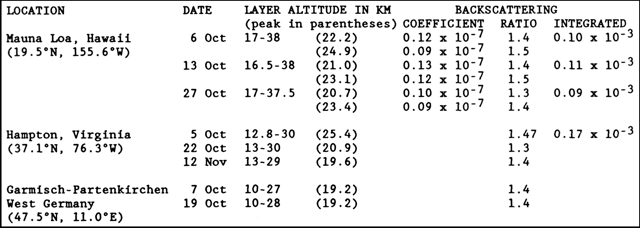Report on Atmospheric Effects (1980-1989) — October 1987

Atmospheric Effects (1980-1989)
Scientific Event Alert Network Bulletin, vol. 12, no. 10 (October 1987)
Managing Editor: Lindsay McClelland.
Atmospheric Effects (1980-1989) Stratospheric aerosols stable or declining
Please cite this report as:
Global Volcanism Program, 1987. Report on Atmospheric Effects (1980-1989) (McClelland, L., ed.). Scientific Event Alert Network Bulletin, 12:10. Smithsonian Institution.
Atmospheric Effects (1980-1989)
All times are local (unless otherwise noted)
Stratospheric aerosol concentrations measured by lidar from Hawaii, Virginia, and Germany in October remained stable or declined slightly from the previous month (figure 48). Integrated backscatter over Mauna Loa, Hawaii on 27 October was the lowest since the 1982 eruption of El Chichón.
Information Contacts: Thomas DeFoor, Mauna Loa Observatory, P.O. Box 275, Hilo, HI 96720 USA; William Fuller, NASA Langley Research Center, Hampton, VA 23665 USA; Horst Jäger, Fraunhofer-Institut für Atmosphärische Umweltforschung, Kreuzeckbahnstrasse 19, D-8100 Garmisch-Partenkirchen, West Germany.

